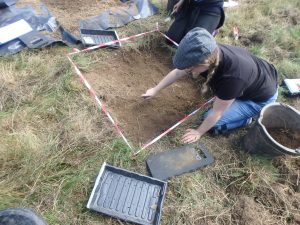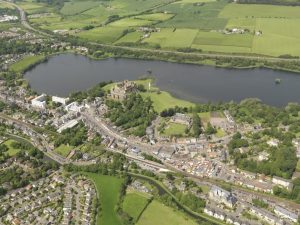
Digging an archaeological test pit
Buried beneath the back gardens of Linlithgow High Street may be objects or archaeological remains from Linlithgow’s medieval past. A new plan is underway to find out more about this hidden heritage, part of an overall project funded and supported by the Heritage Lottery Fund, LEADER and West Lothian Council. Volunteers will soon be participating in this investigation, playing an important part in digging up their town’s history.
Digging will take place, over the weekend of 14–16th September 2018. The test pits will measure 1 m by 1 m and will be in selected back gardens of Linlithgow’s High Street. The work will be supervised by experienced archaeologists from GUARD Archaeology, who will guide and train each volunteer in hand excavation, finds discovery and identification, recording of discoveries and dating of artefacts.

Linlithgow from the air
The medieval burgh of Linlithgow is first recorded in the reign of David I (1124-53), when the king granted the ‘church of Linlidcu with chapels and lands inside the burgh and outside, and all rights pertaining to the foresaid church’ to St Andrews Cathedral in 1140 or 1141.
‘The burgh was a long single street, the High Street, forming part of the route westwards from Edinburgh to Stirling and Glasgow, with a shorter arm, Kirkgate, leading northwards to the royal palace and the parish church,’ said Iraia Arabaolaza from GUARD Archaeology. ‘This is an exciting way to find out more about Linlithgow’s history from the core of its medieval town.’
‘We are really excited to be working with GUARD Archaeology to find out what is underneath the streets of Linlithgow,’ added Stuart Kennedy from Linlithgow Heritage Trust. ‘This project is an important part of the lead up to the Museum reopening in 2019 and becoming a real community focused space.’

the project is funded by the organisations above
